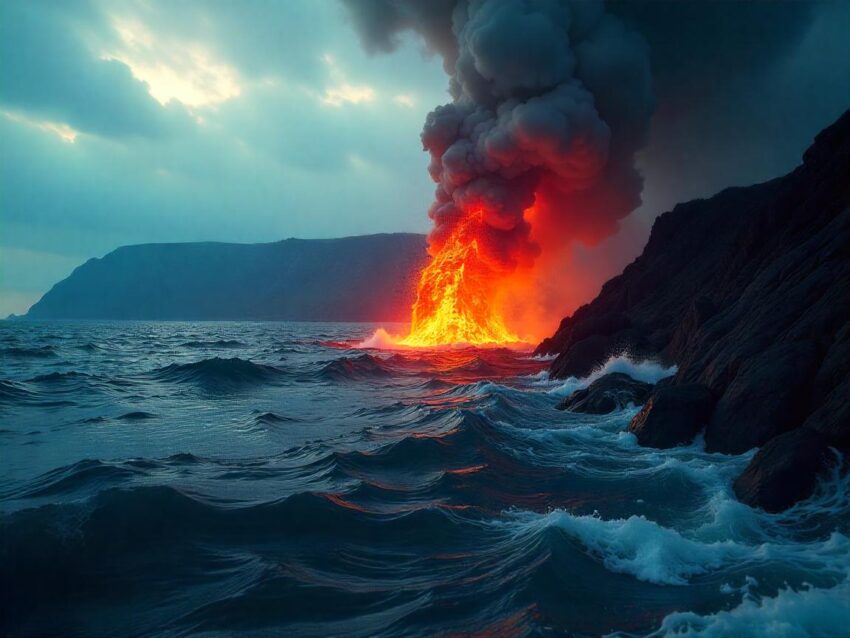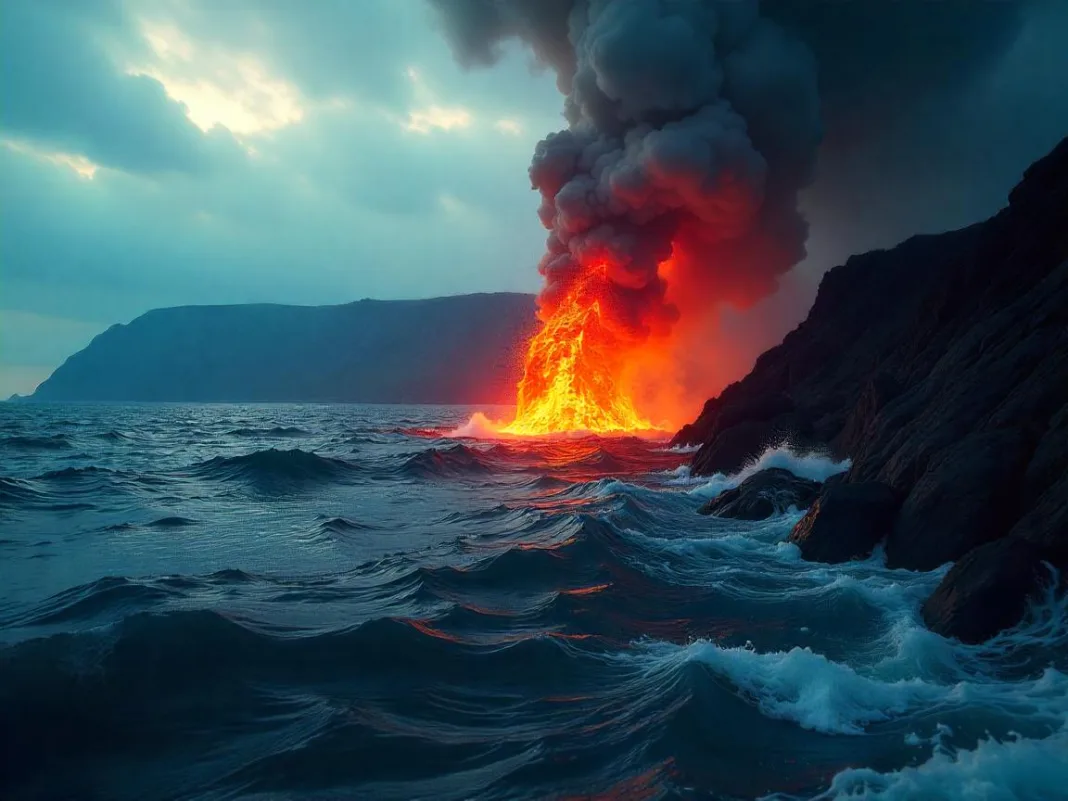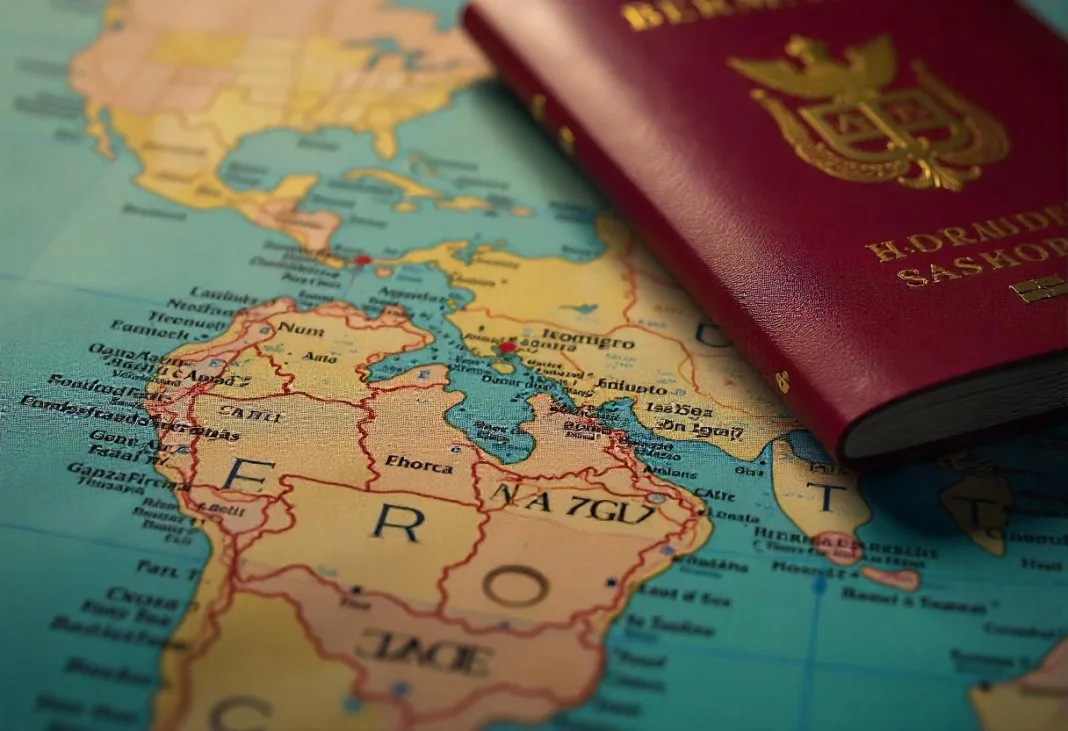Sunday, July 20, 2025

In a startling development, the US state of Oregon has joined the ranks of regions like Vanuatu, Guam, Tonga, Iceland, and the Philippines in facing an urgent warning about underwater volcanic activity. While these volcanic events are typically hidden beneath the ocean’s surface, their potential impact is anything but subtle. Oregon, long known for its dramatic coastlines and rich natural beauty, now finds itself in the spotlight due to the growing seismic activity beneath the Pacific Ocean.
Scientists are closely monitoring the situation, as these underwater eruptions can significantly disrupt marine ecosystems, alter shipping routes, and even affect local economies, particularly in regions reliant on marine industries. What is more concerning is the unpredictable nature of these volcanoes, which makes forecasting their eruptions a complex challenge. As the world watches, the deep ocean’s hidden secrets are slowly being revealed, raising questions about how these forces of nature could reshape our planet’s future.
An urgent warning has been issued by experts, as the mighty Axial Seamount, an underwater volcano located off the Oregon coast, experiences an alarming surge in seismic activity. This remote yet highly active volcano is showing all the signs of an impending eruption, and travelers need to take notice.
For weeks, scientists have tracked hundreds of small earthquakes every day, a clear indicator that magma is slowly rising beneath the ocean’s surface. With tremors now occurring as frequently as 300 times per day, experts are concerned that Axial Seamount could soon erupt, sending shockwaves through the Pacific Northwest region and beyond. The quakes are small in magnitude, but their frequency and proximity to a vast underwater magma chamber make them significant.
Why Axial Seamount’s Activity is a Major Concern for Travelers
The Axial Seamount is no ordinary volcano. Situated about 300 miles off the coast of Oregon and nearly a mile beneath the ocean’s surface, it has been identified as one of the most active volcanoes in the Pacific Northwest. Unlike terrestrial volcanoes that may directly threaten nearby populations, the impact of an eruption here could have far-reaching consequences, particularly on ocean travel and the coastal environment. The volcano’s eruptions are known to form massive underwater lava flows, and its seismic activity triggers severe disruptions to the sea floor.
Scientists have been closely monitoring this activity, and the recent acceleration in earthquakes is worrying. The tremors may not be felt by people directly, but their implications for the ecosystem and regional tourism could be far-reaching. Historically, when Axial Seamount erupts, the seafloor has sunk by as much as eight feet, causing dramatic environmental shifts. If an eruption does occur, local tourism infrastructure in coastal regions might experience disruptions due to the unpredictable effects on marine life, fishing activities, and regional environmental conditions.
The Uncertainty and Urgency Surrounding Axial Seamount
Axial Seamount’s swelling and frequent seismic activity are reminders that volcanoes are not easily predictable. While magma is undoubtedly moving beneath the surface, the exact timing of an eruption remains uncertain. One thing, however, is clear: pressure is building. Scientists have installed sophisticated underwater sensors and GPS stations to track every quake, but there’s still a considerable amount of unpredictability. In fact, the most troubling aspect of this situation is that the volcano has not followed a uniform pattern of swelling like past eruptions, making it harder for experts to forecast exactly when the next big eruption might occur.
The volcano’s inflation, measured at roughly eight inches annually, may sound like a slow process, but it’s enough to signal an eruption in the making. If history repeats itself, an eruption could trigger even more violent quakes, some estimates predicting up to 10,000 quakes within just one day when the eruption strikes. The possibility of lava flowing from unexpected cracks in the Earth’s crust, known as dikes, adds another layer of complexity to predicting where and how this event will unfold.
What Does This Mean for Tourism and Travel in the Region?
Though the Axial Seamount lies far beneath the ocean’s surface, the ripple effects of a potential eruption could extend to the surface world, particularly for tourism industries in Oregon and Washington. Coastal tourism, including cruises, ocean-based excursions, and marine research, could experience disruptions if the volcano erupts. Additionally, marine traffic may be impacted due to potential oceanic changes and seismic activity in nearby waters. Airlines and regional transportation services could also face delays or reroutes, particularly in the event of unexpected environmental shifts.
Experts suggest that although the volcano’s eruption would not pose a direct threat to human life in the region, the ecosystem changes could create short-term challenges for travelers planning trips to the Pacific Northwest. Marine research stations and eco-tourism services could face uncertainty in scheduling, and local governments may issue advisories to prevent unnecessary travel to affected regions.
The Global Implications: How This Affects the Broader Travel Industry
Beyond regional disruptions, Axial Seamount’s rumblings could offer critical lessons for the broader travel industry. For instance, the uncertainty surrounding this event highlights how unpredictable natural events—such as volcanic eruptions—can affect global air and sea traffic. The eruption could disrupt shipping routes, cause cancellations of sea-based tourism, and lead to temporary rerouting of flights in the event of airspace or maritime zone closures. Given the global interconnectedness of travel, a significant eruption could create a ripple effect across the industry, from airfares to hotel bookings, especially for those travelers planning trips to nearby regions.
As scientists continue to monitor the situation closely, there is no definitive answer as to when Axial Seamount will erupt. However, it is clear that the potential for a large-scale eruption is growing, and it could happen sooner than expected. For those planning to travel to the Pacific Northwest in the coming years, staying informed and remaining flexible is crucial. Tourists are advised to pay attention to updates from local authorities and to consider the environmental risks before embarking on their travel plans.
Underwater volcanoes, often hidden beneath miles of ocean, are some of the most powerful and mysterious forces on Earth. While their eruptions may not directly affect human populations, they can have profound effects on marine ecosystems, shipping routes, and regional tourism industries. Recent volcanic activity has brought several of these submerged giants into the spotlight, raising questions about their potential impact on the surrounding regions. From creating new islands to disrupting local economies, here’s a look at how these underwater volcanoes are shaping the world below—and above—the surface.
Axial Seamount: A Volcano on the Verge of Eruption
Axial Seamount, one of the most active underwater volcanoes in the Pacific Northwest, has been showing signs of an impending eruption. Located about 300 miles off the coast of Oregon, this volcano has experienced frequent seismic activity, with as many as 300 earthquakes detected per day. Scientists are closely monitoring this activity, which could result in an eruption by the end of 2025. While Axial Seamount’s eruption would not pose a direct threat to human life, it could impact regional marine industries such as fishing and shipping.
For travelers in Oregon, the effects of Axial Seamount’s potential eruption could be felt in coastal tourism and marine activities. Coastal cities like Portland and Astoria could face disruptions due to shifts in marine ecosystems, as well as changes in shipping routes. The allure of the Pacific Northwest’s coastal beauty may be marred by these environmental changes, urging tourists to stay informed about the latest developments in the region.
Home Reef: A New Island Emerges from the Depths
In the South Pacific, the eruption of the Home Reef volcano near Tonga has created an entirely new island. This is a rare phenomenon that offers a unique opportunity for travelers and scientists alike. By June 2024, the island had grown to 12.2 hectares, a testament to the immense power of underwater volcanic eruptions. While the creation of new land is exciting, it also presents new challenges. Changes in marine conditions could affect local fisheries and tourism.
For visitors interested in exploring this new island, it’s important to remember that volcanic activity is unpredictable. The region’s remote location means that tourism infrastructure is limited, and any sudden eruptions could affect accessibility. However, the allure of a new island on the Pacific’s horizon is undoubtedly a draw for adventurous travelers looking to experience a natural wonder in its rawest form.
East Epi: Vanuatu’s Volcanic Activity and Its Regional Impact
East Epi, part of the volcanic complex in Vanuatu, is another area of concern for those traveling in the South Pacific. The area has experienced intermittent volcanic eruptions, with the most recent explosion occurring in early 2023. These eruptions are typically explosive and have the potential to disrupt local infrastructure, including transportation and energy systems. For those planning to visit Port Vila, the capital city of Vanuatu, it’s essential to stay updated on volcanic activity.
Vanuatu is known for its beautiful beaches and pristine marine life, which could be affected by continued volcanic activity. Although these eruptions are unlikely to endanger travelers, disruptions to local services and the potential for environmental shifts make it important to keep an eye on updates from local authorities.
Kanlaon Volcano: Ongoing Eruptions in the Philippines
In the Philippines, Kanlaon Volcano on Negros Island has been showing signs of increased activity. Recent eruptions have displaced thousands of families and caused significant damage to local agriculture. While the volcano is land-based, its effects on nearby cities, such as Bacolod City and La Carlota City, are a reminder of the far-reaching impact of volcanic activity. Travelers to the region may experience disruptions in transportation and regional tourism.
For tourists planning to visit the Philippines, the ongoing activity at Kanlaon highlights the importance of checking for travel advisories before booking flights or making travel arrangements to nearby areas.
Underwater Volcanoes: Nature’s Hidden Giants Shaping the Earth Beneath Our Feet
Volcanoes, typically associated with fiery eruptions and dramatic lava flows, are not always as visible as the towering peaks we see on land. In fact, the vast majority of the world’s volcanoes are hidden beneath the ocean’s surface, their activity shaping the landscape of our planet in ways most of us can’t see. While their eruptions are often far from populated areas, the effects of these underwater giants can be global in scale. From the creation of new islands to sudden shifts in marine ecosystems, underwater volcanic eruptions are vital to understanding Earth’s geological processes. This guide explores the latest activity from some of the world’s most active underwater volcanoes and examines how they impact not just the science world but also regional tourism and global environmental health.
Axial Seamount: The Pacific Northwest’s Volcano Awakens
Axial Seamount, located approximately 300 miles off the coast of Oregon, is one of the most well-known and closely studied underwater volcanoes in the world. This massive volcano, sitting nearly a mile beneath the ocean’s surface, has erupted three times since its discovery in 1998, with the last eruption taking place in 2015. Over the past few months, scientists have noticed an uptick in seismic activity surrounding Axial Seamount, with around 100 earthquakes occurring daily, and some days seeing up to 300 tremors. This unusual frequency has scientists concerned that an eruption could be imminent, with predictions suggesting it could happen as soon as the end of 2025.
What makes Axial Seamount particularly fascinating is that its eruptions are a critical part of scientific studies on the Earth’s tectonic processes. Each eruption provides data on the movement of magma beneath the ocean floor, helping scientists understand how underwater volcanoes evolve. For travelers heading to Oregon or the broader Pacific Northwest region, these volcanic activities might not directly affect travel routes or destinations, but they contribute to an ever-changing natural environment. Researchers continue to monitor the volcano’s surface, which has swollen by up to eight inches annually, as magma rises beneath the surface. The upcoming eruption could trigger massive changes to the seafloor, reshaping the surrounding marine ecosystems and potentially disrupting nearby marine industries like fishing.
Ahyi Seamount: An Active Force in the Mariana Trench
The Ahyi Seamount, located near the Mariana Trench, is another of the Pacific’s underwater giants making waves in the scientific community. This seamount, which has experienced several eruptions over the past two decades, saw significant activity again in 2024, with ash and gas released into the surrounding waters. The proximity of Ahyi Seamount to the deep ocean trench adds to the scientific intrigue, as eruptions here provide valuable insights into subduction zone volcanism. When one tectonic plate slides under another, it can cause magma to rise to the surface, creating a series of explosive volcanic events.
The eruptions of Ahyi Seamount are particularly important for researchers studying the behavior of underwater volcanoes in areas where tectonic plates are converging. While these eruptions are far from land and do not pose a direct risk to human life, they offer a chance to understand how subduction zones behave and how such events can affect the surrounding deep-sea ecosystem. The beauty of the Mariana Trench and its surrounding areas remains relatively untapped for tourism, largely due to the remoteness of the region. However, there is growing interest in underwater exploration and deep-sea tourism that could provide a glimpse into these dynamic geological formations.
Home Reef: The Birth of a New Island
Among the most captivating events triggered by underwater volcanic activity is the formation of new islands. In 2022, the Home Reef volcano in Tonga erupted violently, and in the months that followed, a new island emerged in the Pacific Ocean. By June 2024, satellite images confirmed the island had grown to over 12 hectares (30 acres). Home Reef, which is located in the South Pacific, is a fascinating example of how an underwater volcano can not only reshape the ocean floor but create new landmasses that can potentially alter local ecosystems and offer new opportunities for study and exploration.
New islands formed by volcanic eruptions are rare, and their formation is a spectacular natural event. For travelers, the idea of visiting a new landmass, shaped by nature’s unpredictable forces, presents an allure like no other. However, the eruption of Home Reef has not been without its challenges. While the new island might spark interest in tourism, the volatile nature of volcanic activity in the region means that it is still unclear how stable or permanent this island will be. Additionally, the eruption has raised concerns about the impact on marine ecosystems, particularly for local fisheries, which could experience both positive and negative shifts due to changes in the surrounding environment.
East Epi: Persistent Volcanic Activity in Vanuatu
The East Epi volcanic complex, located in the Vanuatu region of the South Pacific, is another example of persistent volcanic activity beneath the ocean’s surface. This area, part of the Pacific “Ring of Fire,” has witnessed numerous eruptions over the past decades, with the most recent significant event taking place in early 2023. The volcanic activity here includes both explosive and non-explosive eruptions, often characterized by phreatic explosions, where superheated water vapor causes the release of steam, ash, and gas.
East Epi is particularly interesting because it is part of an active volcanic island arc that stretches from the Philippines down through Indonesia and the Pacific islands. While tourism in the region has been relatively stable, the continued volcanic activity poses ongoing risks for local infrastructure, including roads, power lines, and housing. For travelers planning to visit Vanuatu, it’s important to stay informed about potential volcanic risks, as local governments monitor these events closely to ensure the safety of visitors and residents alike.
Sundhnúkur Crater Chain: Iceland’s Underwater Volcanic Series
Iceland, known for its dramatic land-based volcanic activity, is also home to several underwater volcanic systems that contribute to its unique geological features. The Sundhnúkur crater chain, located beneath the Reykjanes Peninsula, has been particularly active in recent months. Since December 2023, a series of eruptions and seismic tremors have been recorded, with over 20,000 tremors by November 2023 alone. The volcanic activity has resulted in land subsidence and the formation of graben valleys, which could have a significant impact on Iceland’s infrastructure, particularly in terms of power generation and pipeline systems.
For travelers heading to Iceland, this volcanic activity may not directly affect most tourism sites, but it offers an incredible opportunity to witness the raw power of the planet. The country’s hot springs, geysers, and volcanic landscapes already draw millions of visitors each year, and the increased activity beneath the surface adds another layer of intrigue to the destination. Travelers can learn more about these natural forces by visiting the island’s numerous geothermal sites or participating in tours that take them near volcanic craters and lava fields.
Kanlaon Volcano: A Persistent Threat in the Philippines
Kanlaon, located on Negros Island in the Philippines, is another active volcano that has seen a surge in activity in recent months. While Kanlaon is a land-based volcano, its eruptions often have widespread implications for local ecosystems and tourism. In 2024, the volcano began to erupt intermittently, with significant explosive events affecting nearby communities. The ash clouds from these eruptions have displaced thousands of families and caused extensive damage to local agriculture.
Kanlaon’s activity underscores the risks that volcanic eruptions pose to nearby populations. While the volcano is not underwater, its eruption patterns are similar to those of underwater volcanoes in that they involve the release of magma, ash, and gas into the atmosphere. For travelers planning to visit the Philippines, it is essential to stay updated on the status of Kanlaon and other active volcanoes in the region. Tourism to areas near the volcano may be restricted during heightened activity, and travelers should be aware of potential disruptions in flights and local infrastructure.
The Afar Depression: The Formation of a New Ocean
One of the most fascinating regions for studying volcanic activity is the Afar Depression, located in East Africa where the African, Arabian, and Somali tectonic plates meet. This area is known for its volcanic activity and the gradual process of continental rifting. Recent studies have shown that lava bursts from Earth’s mantle are contributing to the slow splitting of the African continent. This rifting process may eventually lead to the formation of a new ocean.
While the Afar Depression is a remote region, it holds immense significance for geologists studying the process of plate tectonics and continental drift. The potential for new landmasses and ocean basins to emerge in this region could have long-term environmental and economic consequences. Although the Afar Depression is not a typical tourist destination, it presents a unique opportunity for scientific exploration and study of one of Earth’s most dynamic geological processes.
Conclusion: The Hidden Power of Underwater Volcanoes
Underwater volcanoes are among the most powerful natural forces on Earth. Their eruptions shape the planet’s surface, create new landmasses, and affect the surrounding ecosystems in ways that we are only beginning to fully understand. While these volcanic events may not pose an immediate threat to most travelers, they offer incredible opportunities for scientific exploration and discovery. Whether it’s the creation of new islands or the eruption of massive seamounts deep beneath the ocean’s surface, these natural wonders continue to captivate scientists and travelers alike. Understanding the implications of underwater volcanic activity not only enriches our knowledge of Earth’s geology but also reminds us of the forces that continue to shape our world, both above and below the waves.
Conclusion: Stay Vigilant as Axial Seamount Inches Closer to Eruption
The increase in seismic activity around Axial Seamount is a stark reminder of nature’s unpredictable power. Whether you’re planning to visit the Pacific Northwest or simply want to stay informed about natural events affecting global travel, now is the time to pay attention. As experts continue their work, the world waits, watching closely for what may come next.







